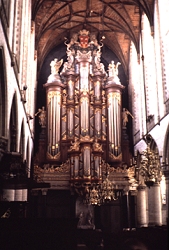|
For those of us who live in the United States, the eighteenth century means one thing in particular: The Revolutionary War and the founding of our country. Revolution marked the end of the century in Europe as well, as events in France spilled over borders and effectively established a new order there. Before these cataclysmic happenings, though, the eighteenth century was a time of continued development in several organ-building regions.
- In Colonial North America, importations from Spain (in Mexico), France (in Canada), Germany and England (the United States) brought not only instruments but also builders to the New World. These national styles of course affected instruments built in the respective regions of North America, laying the groundwork for new work to follow.
- In France and Italy the traditions of the past century followed a slow line of development that lead not to new national types but to some monumental creations that expanded upon their predecessors. Some of the outstanding monuments to builders' imagination and skill -- at Poitiers and St. Maximin-en-Var, for example -- are today pilgrimage sites for organists the world over.
- In Saxony, the work of Gottfried Silbermann is today associated with the organ works of Johann Sebastian Bach. His instruments form a body of work that complements the North German instruments of the earlier Schnitger. They not only embodied a different aesthetic, they even introduced some new sounds -- strings, in particular -- to the organ. In the north, and even in Holland to the west, major monuments to the builder's art -- such as the St. Bavo instrument pictured at the top of this page -- form another corpus of pilgrimage instruments.
- In England, after the turmoil of the seventeenth century, the introduction of the "swelling organ" early in the century was the most important development. This small innovation remained a peculiarly English trait for the rest of the century, one that would remain important for generations.
The almost limitless variety of expression which we find in the music of the eighteenth century is related to the instruments, of course. From Bach, to the late eighteenth-century "noëlistes," to the Viennese masters who wrote for clock organs, musicians continued to write music for the organ -- of whatever national type they found available.
|

